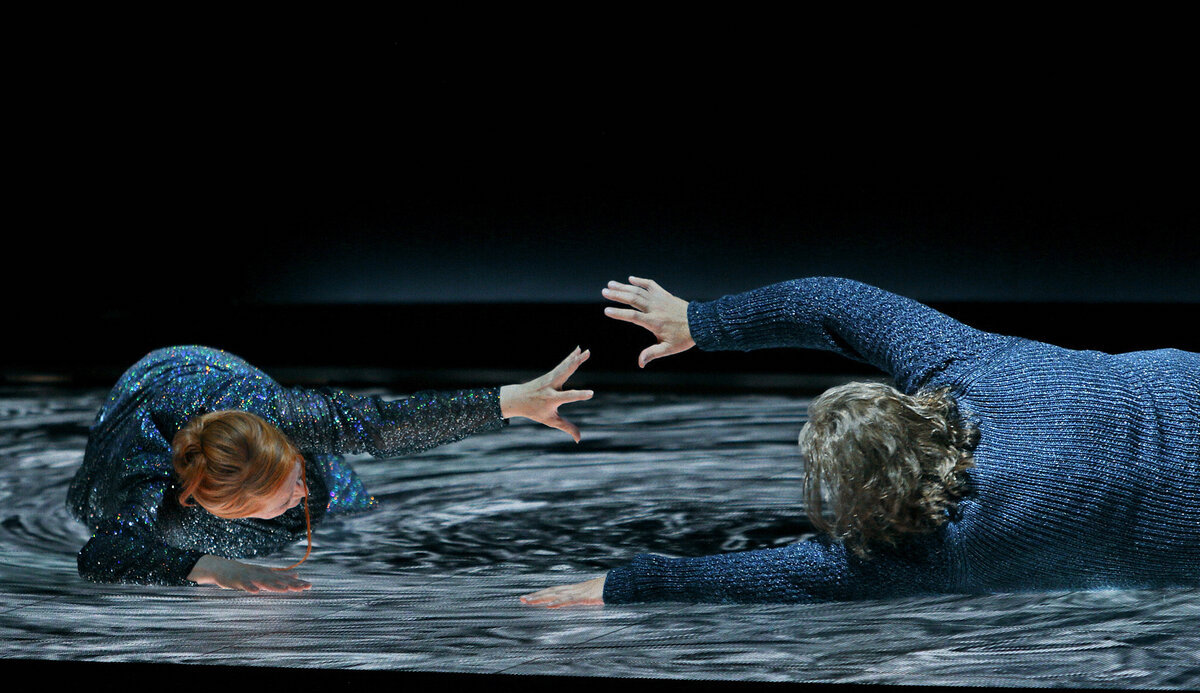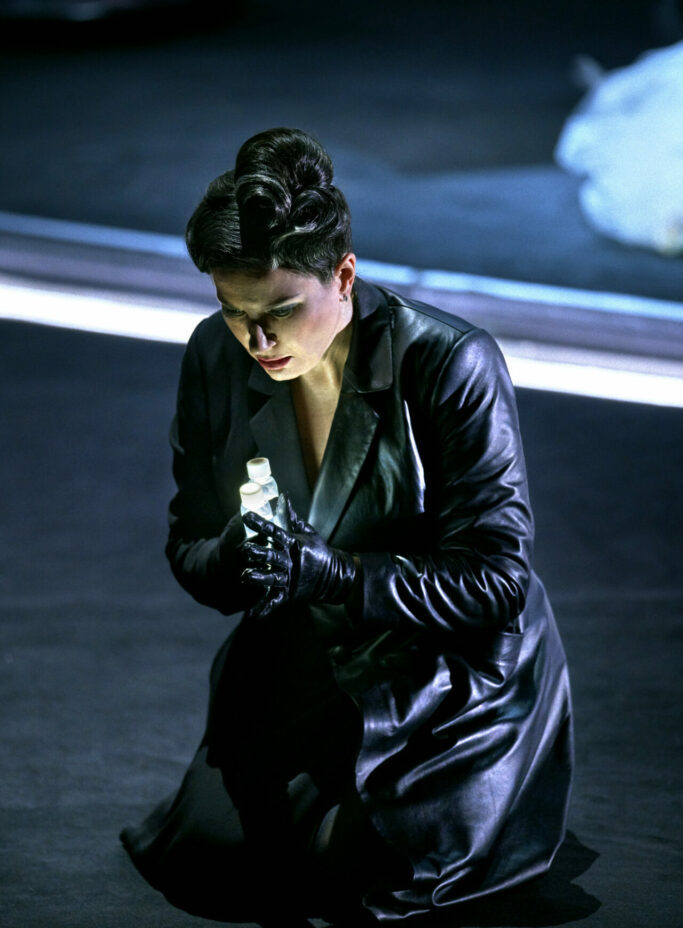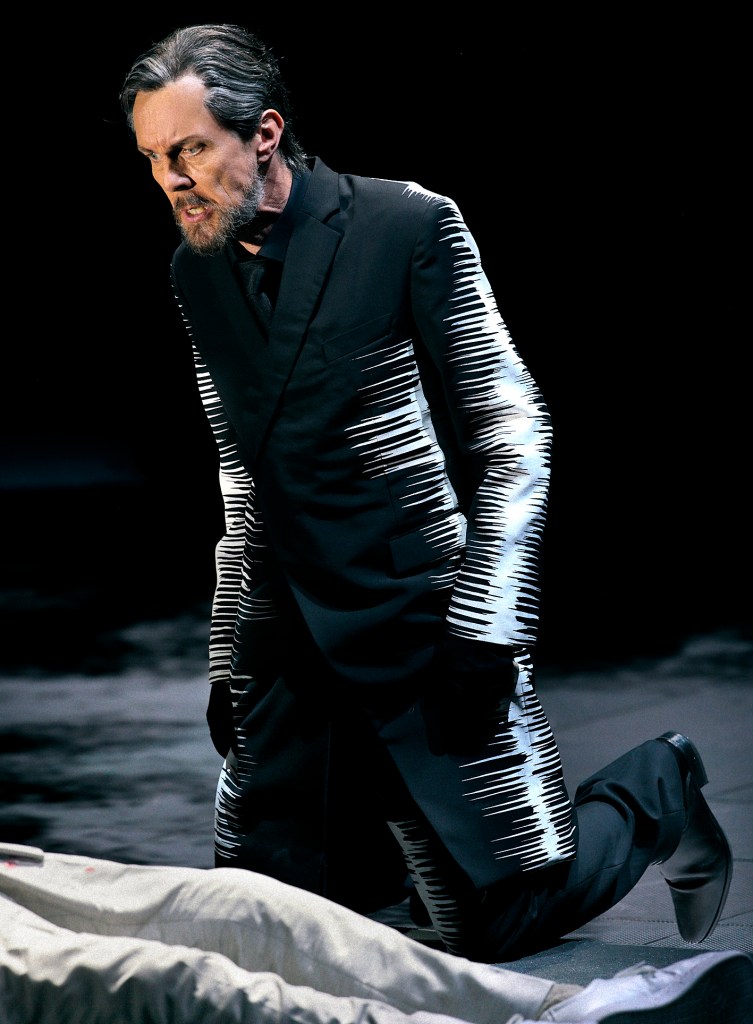“Is this what you wanted,” Leonard Cohen asks in the refrain of his eponymous song, “to live in a house that is haunted by the ghost of you and me?” With the Bayreuth Festival traditionally opening the house for each performance by having members of the orchestra’s brass section play an appropriate snippet of the evening’s opera from the house’s outdoor balcony, I’d like to offer up this Cohen gem (from 1974’s “New Skin for the Old Century”) as an alternative suitable to any occasion.
The question of whether we still need Bayreuth has been asked plenty of times. So, too, has the question of how we reconcile Bayreuth with its past. Many are quick to answer the latter with an insistent “that was then, this is now.” Audience members who would have worn swastikas on their lapels 90 years ago now sport pins with the logo for the UN’s Sustainable Development Goals. For the last decade, festival-goers who wish to see Arno Breker’s towering bronze cast of Wagner’s head must first cross through an exhibit called “Silenced Voices,” which pays tribute to the Bayreuth artists whose careers (and, at times, lives) were extinguished by the Third Reich. It’s the German version of acknowledging in the footer of your website the original native occupants of the land on which your podcast studio now sits.
But, going up the Green Hill on Monday night for the opening of the 2022 festival, my first view was not of Wagner’s My Little Pony opera house. It was of a group of demonstrators led, I would later learn, by neo-Nazi Sven Liebich, holding red flags with white circles dotted by black icons (in this case, the currency symbol for the Euro). To drive home their point that the real Nazis are the ones at the head of Germany’s current and recent governments, a large, gothic font banner read “Heil Merkel!” When I asked one of the police officers lining Siegfried-Wagner Allee what was going on, he shrugged, blasé and somewhat bemused. “Normal,” he replied. Just a few hours before, I’d read an interview with Roland Schwab, director of the festival-opening “Tristan und Isolde,” in which he described this new production as “an escape from the real world.”
It’s hard, if not foolhardy, to escape the real world when you’re flanked by literal Nazis.

“Tristan” wasn’t initially slated for this season at Bayreuth. The main event of the festival is a new “Ring” Cycle, directed by Valentin Schwarz and initially set to open the 2020 season before the realities of corona set in. In December of 2021, Schwab was tapped at the last minute to create a new iteration of “Tristan” (replacing Katharina Wagner’s own 2015 production). The move was made mainly out of pragmatism in an increasingly unpredictable environment of variants and cancellations, as true at the end of 2021 as it is in the summer of 2022: Just ten days before the opening of “Tristan,” its original conductor, Cornelius Meister, switched over to the “Ring” Cycle (replacing a COVID-stricken Pietari Inkinen), leaving Markus Poschner to take the podium for opening night. If needed, a new “Tristan” could easily replace any of the more cast- and chorus-heavy productions of the season. Schwab produced a full concept for initial workshops four weeks after signing his contract.
Whereas other Bayreuth directors have habitually worked in an understanding of Wagner’s legacy against the events of the 20th century—Barrie Kosky’s “Meistersinger,” Frank Castorf’s “Ring”—Schwab abdicates all sense of history, something he argues that Wagner condoned with his libretto. The geopolitical machinations that bring the lovers together are likewise inconsequential. He even abandons the psychology of Tristan and Isolde in favor of the beauty of their love story and its eternal nature. (This is rendered unnecessarily literally in an illuminated red sign on one of the corners of the stage reading “eternity” in—for no discernible reason—Hindi.) The prelude begins and soon the curtain opens to reveal two young children sitting stone-still, calling to mind the twins from “The Shining” more than the idea of young love. These symbolic sweethearts return twice more, as young, seemingly postcoital adults in Act II and an elderly couple in Act III. They take over the “Liebestod,” shuffling in and moving in opposite directions around the set before meeting once more as they come full circle. A scrim comes down to obscure the other characters. Hand-in-hand, the couple punctuate the final chords of Isolde’s aria by tilting their heads in towards one another like a pair of marzipan wedding cake toppers. Where’s Isolde? I imagine the policeman from outside shrugging in response.
The latest from VAN, delivered straight to your inbox
To an extent, both Tristan and Isolde are inconsequential to the story Schwab is telling. His circular set is divided between two levels: one onstage, another a few yards above. Isolde never leaves the lower level; we only see Tristan on the upper level once in the opening of the opera. They’re caught in the manifold descents in Wagner’s libretto, captured in the multiple meanings of the verb sinken: The sun doesn’t set. Night doesn’t descend. Swords aren’t laid down. Lovers don’t embrace. They all sink. Isolde’s final lines of the opera are “ertrinken, versinken, unbewusst; höchste Lust!”—to drown, to sink, unconscious, is the highest pleasure. Schwab’s aim is to celebrate this pleasure, to luxuriate in a house haunted by the ghost of Tristan and Isolde’s love, but the net effect is akin to Christopher Walken’s scene in “Annie Hall” (another work by a problematic creator) when he tells Woody Allen that he has an impulse to drive into oncoming traffic to experience the shattering of glass and flames rising out of spilled gasoline: “I have to go now,” Allen’s character stammers, “because I—I’m due back on planet Earth.”
In treating Tristan and Isolde as the archetypes of a utopian form of love, one that serves as an escape from the self, Schwab eradicates the characters. Catherine Forster’s Isolde is a void, moving initially with broad, clichéd gestures in Act I while wearing sunglasses as a further measure of protection against seeing and being seen. Stephen Gould’s Tristan has a similar range of poses (buttressed by a stronger tone and musicality); if her posturing initially calls to mind Little Orphan Annie, he seems to be auditioning for “Jesus Christ Superstar.” They begin to detach from reality at an accelerated pace after drinking the love potion, showing little reaction to the events going on around them and moving in ways increasingly stiff and oblique. Much of the motion in their story comes from a projection on the floor of the stage that initially represents a pool in Isolde’s ship quarters and, in later acts, swirls with a hurricane-level vortex of stars.
But there’s little connection for the audience to latch onto during this descent. We’re not so much losing ourselves with the lovers as we are standing on the upper level looking down. I’ve never felt more sympathy for King Marke when he asks his nephew to explain his betrayal and the uncharted depths of its causes. I’ve never felt more antipathy towards Tristan when he responds emphatically: “That I cannot tell you.” When Isolde holds up a beseeching hand to Marke at the end of his soliloquy, he looks at it crestfallen. The wool has come off his eyes and he realizes that this will never be what he wanted. Perhaps he even knew this from the beginning, but chose to file it away as something he couldn’t see versus something he willfully obscured. Despite his brief stage presence in comparison to the title characters, the musical strength of Georg Zeppenfeld’s Marke combined with a naturalistic delivery that speaks to the psychological turmoil of his position, one that he grapples with in real time, leads to this being Marke’s story more than the lovers.


It’s also Brangäne’s story: Ekaterina Gubanova experiences her own conflict between duty to her mistress and her residency on planet Earth. It’s the latter that leads her to defy Isolde’s orders and replace the poison she demands for herself and Tristan with a love potion. Nicol Hungsberg’s lighting accentuates this; as Isolde raves like King Lear, Brangäne’s shadow against the lower level’s wall looms large over her lady’s. She may be a servant, but she’s the one with the power. When Marke enters in Act III, finding Tristan dead and Isolde on the brink herself and demands “Why?” of his wife, Brangäne subtly retreats into the shadows. This isn’t what she wanted, either. But both she and Marke are left to clean up the mess.
It’s easier to side with Marke and Brangäne, but when the real thrust of “Tristan” is an opera steeped in time-stilling desire, in the morbid and masochistic fascination of holding’s one hand over a flame, this also feels like a lackluster side to be on. The legend of Bayreuth is that it offers a heightened plane to experience both reality and the supernatural. A €7.50 bottle of water is normal—and, after sitting in an unventilated opera house with 1,900 other people on a 90-degree afternoon, there’s something erotic about that first glug. But then you pull the glass bottle from your lips and realize where you are: in a spectacle of society, surrounded by the international elite brandishing fans and program insets, complaining about the recent spike in gas prices while also moaning that opera has gotten “too political” in recent years. Back in the house, whispers between seatmates and the titter of laughter when one of those water bottles tips over with a loud clunk on the wooden floor, lead to missed connecting flights between the mundane and the sublime. As a music critic with a deeply personal connection to Wagner (although this is a misnomer as one’s relationship to Wagner—positive or negative—can only be deep and personal), to reach the Valhalla of the opera world and feel nothing begs a boomerang: Is this what I wanted? Or, to put it another way, how much do the lives of people in the real world need to bend and contort to fit the lives of people living at a remove from reality?
I felt far more transported the following evening in Bayreuth’s Reichshof, a multidisciplinary stage more La MaMa than the Met. Amid programs running the gamut from a lecture on the war in Ukraine given by a crackpot NATO conspiracy theorist to the annual BeatBox Battle Bayreuth, the Reichshof currently serves as a satellite for Bayreuth’s supplementary “Nach Tristan.” Subtitled “a journey from the past backwards into the present,” the hourlong performance (directed by Ingo Kerkhof) has very little to do with Wagner on its surface, save accordionist Felix Kroll working his way through highlights from the opera, like a surrealist restaurant troubadour.
Accentuated by flashes of other texts, the work is largely a combination of scenes from postmodern dramatist Heiner Müller’s apocalyptic “Quartet” and Swedish playwright August Strindberg’s cynical “The Dance of Death.” Müller’s work, in turn, takes the events and characters of Pierre Choderlos de Laclos’s Dangerous Liaisons and casts them somewhere between the novel’s pre-French Revolution setting and the aftermath of World War III, his two characters locked in an eternal game of sex and power. The two actors, Dagmar Manzel and Sylvester Groth, dip in and out of these scenes as nameless characters, threading them with Strindberg’s portrait of a couple fêting their 25th wedding anniversary in a way that presages Edward Albee’s “Who’s Afraid of Virginia Woolf?” but creating an entirely original portrait of a love that has long outlived its life cycle.

The East-German–born Müller’s own operatic debut was a production of “Tristan” for Bayreuth in 1993, one touted at the time as an artistic symbol for the country’s recent reunification—a reunification Müller derided as the “mise-en-scène of forgetting.” While directing Wagner’s work, he found in it parallels with “Quartet,” which had premiered a decade earlier. The sadistic and narcissistic Marquise de Merteuil and the Vicomte de Valmont were, he reasoned, what Isolde and Tristan would have become had they stayed together for ten or 20 years. This balances out with Strindberg’s world, where the Chekhovian naturalism of his characters is undercut by the depths of psychological damage they’ve spent the last quarter of a century inflicting upon one another.
Kerkhof keeps all of this simmering just beneath the surface, never allowing for a moment of Wagnerian gesticulation. The anonymity and mercurial nature of Menzel and Groth’s anonymous characters leaves them also slightly out of the world of the drama (“Too much theater,” Menzel sighs early on in the play). They slip into the roles of Müller and Strindberg as if they are second skins, but skins that have shrunk ever-so-slightly in the wash. As Groth, capitulating to Menzel’s demand, reads through the ruined Madame Tourvel’s tearful plea to Valmont (skirt and all), she observes him with the letdown of a director who can’t get what they need out of their star. When she dances a frenzied can-can abetted by Kroll’s accordion, he sits on the sofa in unblinking silence, a slow internal combustion playing out in his psyche. They seem to be a continual disappointment to one another. In that sense, they could be one of the couples at the previous evening’s opening of “Tristan,” the sort who go to be transformed by the opera and who then go home, crestfallen to realize that they are still the same people, haunted by the same ghosts. ¶
Subscribers keep VAN running!
VAN is proud to be an independent classical music magazine thanks to our subscribers. For just over 10 cents a day, you can enjoy unlimited access to over 875 articles in our archives—and get new ones delivered straight to your inbox each week.
Not ready to commit to a full year?
You can test-drive VAN for one month for the price of a coffee.

